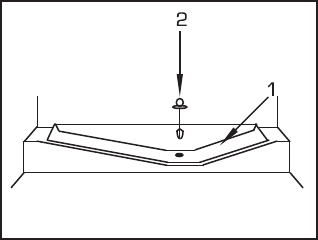
DEFROSTING
A) Fridge compartment
The fridge defrosts automatically.
The defrosting water runs to the drain tube via
a collection channel and is evaporated in
a special container at the back of the appliance
During defrosting, water droplets may form
at the back of the fridge where a concealed
evaporator is located. Some droplets may
remain on the liner and refreeze when
defrosting is completed. Do not use pointed or
sharp-edged objects such as knives or forks
to remove the droplets which have refrozen.
If, at any time, the defrost water does not drain from the collection channel, check
that no food particles have blocked the drain tube. The drain tube can be cleared
by pushing the special plastic plunger provided down the drain tube.
B) Frozen food compartment
Defrost twice a year or when a frost layer of around 7 (1/4") mm has formed.
To start the defrosting procedure, switch off the appliance at the socket outlet and
pull out the mains plug.
All food should be wrapped in several layers of newspaper and stored in a cool
place (e.g. fridge or larder).
Containers of warm water may be placed carefully in the frozen food compartment
to speed up the defrosting.
Do not use pointed or sharp-edged objects, such as knives or forks to remove
the frost.
Never use hairdryers, electrical heaters or other such electrical appliances for
defrosting.
Sponge out the defrost water collected in the bottom of the frozen food compartment.
After defrosting, dry the interior thoroughly. Insert the plug into the wall socket
and switch on the electricity supply.
10
STARTING
Final Check
Before you start using the refrigerator check that:
1. The feet have been adjusted for perfect levelling.
2. The interior is dry and air can circulate freely.
3. Clean the interior as recommended under "CLEANING AND CARE."
4. Insert the plug into the wall socket and switch on the electricity supply.
When the door is open the interior light will come on.
5. You will hear a noise as the compressor starts up. The liquid and gases sealed
within the refrigeration system may also give rise to noise, whether the
compressor is running or not which is quite normal.
6. Slight undulation of the top of the cabinet is quite normal due to the
manufacturing process used, so do not worry, it is not a defect.
7. We recommend that you set the thermostat knob at 3 (three) and monitor the
temperature to ensure the appliance maintains desired storage temperatures
(See section Temperature Control and Adjustment).
8. Do not load the appliance immediately it is switched on. Wait
until the correct storage temperature has been reached. We
recommend that you check the temperature with an accurate
thermometer (see; Temperature Control and Adjustment).
IMPORTANT: Ice formation at the back is normal, do not worry (See Defrosting).
STORING FROZEN FOOD
Your appliance is suitable for the short-term storage of commercially frozen foods
and can not be used to freeze fresh food.
MAKING ICE CUBES
Fill the ice-cube tray 3/4 full with water and place it in the frozen food compartment.
Loosen frozen trays with a spoon handle or a similar implement. Never use sharp
edged objects such as knives, forks.
11












